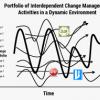Business Transformation Requires Transformational Leaders
Leadership and teaming skills are front and center in times of rapid change. Meet today’s constant disruption head on with expert guidance in leadership, business strategy, transformation, and innovation. Whether the disruption du jour is a digitally-driven upending of traditional business models, the pandemic-driven end to business as usual, or the change-driven challenge of staffing that meets your transformation plans — you’ll be prepared with cutting edge techniques and expert knowledge that enable strategic leadership.
Subscribe to Arthur D. Little's Culture & Leadership Newsletter
Insight
Jon Ward emphasizes the significance of enabling change. He believes that a culture of experimentation is required for digital transformation to succeed. Ward identifies important elements of an experimental culture, such as encouraging innovation and self-directed teams. He also specifies senior leadership behaviors as well as corporate governance approaches needed to build and reinforce an experimental culture.
The authors observe that many classic change management models fail to consider the significant dimensions of technology and innovation. They recommend developing key performance indicators to track all dimensions of change, which will enable an organization to constantly improve its capability to implement change.They also present a case study.
David Coleman discusses three areas affected by digital transformation: customer experience, operational processes, and business models. Successfully transforming each area depends on a collaborative mindset. Coleman defines this mindset and shows how alignment of purpose and commitment to the task go hand in hand with collaboration. He illustrates the importance of a collaborative mindset in transforming processes that touch customers, internal processes, and the overall business model.
The authors highlight the challenge of resistance to change. They believe that leaders charged with digital transformation often ignore or underestimate employee resistance. And sometimes when they recognize resistance, they write it off as irrational behavior. The authors explore this and other misconceptions that stand in the way of effective digital transformation. They propose an approach for involving and engaging employees in the change.
The authors examine the interdisciplinary theory of complex adaptive systems (CAS) and how this theory can be useful in digital transformation. They define nine properties of CAS theory, such as a constant state of flux. For each property, they describe the challenges and opportunities for digital transformation. Finally, they present CAS-based practices that enable change management.
Bill Fox focuses on the importance of forward thinking. He believes that this kind of thinking creates an environment where digital transformation occurs organically. Fox describes 13 foundational forward-thinking abilities, along with three approaches that help create a forward-thinking workplace.
Digital transformation is not for the faint of heart. It means disrupting your company before your competitors do. It means experimenting, without any guarantee of success. It means creating something new and unproven, while sabotaging what’s already working. Digital transformation means taking big risks. We are pleased to have nine authors share their change leadership insights in this issue.
Blockchain Rising, Part VIII: Design and Development Trends
This Executive Update focuses on surveyed organizations’ use of in-house developers versus outside specialists for blockchain development efforts as well as a general overview of open source and commercial vendor blockchain platforms.



















